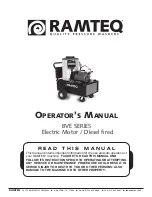
10
Important Trailer Safety Information
Safety Chains
Listed in the chart below are the different class sizes of
safety chains and the rated load each chain must be
capable of withstanding.
WARNING: Failure to properly attach safety chains
between the trailer and tow vehicle can result in a
runaway trailer.
WARNING: To avoid accidents, before trailering:
•
Hitch only to ball size marked on coupling.
•
Ball clamp must capture ball and lever or hand
wheel is fully clamped.
•
Cross safety chains under coupling.
•
Allow only enough slack for turns.
The safety chains on your trailer are an added
insurance that it will not become detached from the tow
vehicle. All safety chains are provided with an added
clasp to keep them from becoming accidentally
detached from the tow vehicle. Your trailer hitch on the
tow vehicle should have two attaching holes or rings for
attaching the safety chains, preferably one on each
side of the ball hitch. Crisscross the chains under the
tongue, the chain on the left side of the trailer tongue
attached to the right side of the ball hitch, the chain on
the right side of the trailer tongue attached to the left
side of the ball hitch.
This prevents the trailer tongue from dropping to the
road should the coupler or ball hitch fail. The chains
should be rigged as tight as possible with just enough
slack to allow tight turns to be made. This can be
accomplished by twisting the chain hook in a clockwise
or counterclockwise direction thus twisting the link
spacing and making the chain shorter. Also by keeping
your chains as short as possible you prevent them from
dragging on the road and wearing the chain links. If for
any reason you find it necessary to replace a safety
chain, use only original equipment.
Load-Carrying Capacity
Located on the front left-hand side of the frame, (either
the inside or the outside) is the VIN (Vehicle Identifica-
tion Number) tag. It will show the GVWR (Gross Vehicle
Weight Rating) which is the maximum load that can be
applied to the tires on the trailer. The GVWR and the
carrying capacity of the trailer are based on the tire size
installed on the trailer.
The GVWR is the maximum carrying capacity of the
trailer with its respective tires. It may not necessarily
equal the total GVWR of the trailer less the empty
weight of the trailer because there may be another
controlling factor such as frame strength that reduces
the carrying capacity to what is listed on the VIN tag.
The tire label will list the tire size that was installed on
the trailer as original equipment when it was sold to
you, the consumer. It also lists the maximum carrying
capacity of the trailer.
IMPORTANT: The total weight of the load must
never exceed the weight of cargo listed on the tire
label and/or the maximum load carrying capacity
listed on the VIN tag on your trailer. The GVWR
(Gross Vehicle Weight Rating) listed is the
maximum total weight of the trailer with accesso-
ries and all cargo allowable to be carried on the
tires that are installed on the trailer.
WARNING: Fishtailing caused from improper
tongue weight on the tow vehicle hitch ball can
cause loss of control of the tow vehicle and
resulting serious injury or property damage.
TRAILER
CLASS
TRAILER
WEIGHT GVWR
IN LBS.
MINIMUM BRAKING
STRENGTH IN LBS.
I
to 2,000
2,000
II
2,000 to 3,500
3,500
III
3,500 to 5,000
5,000
Karcher HDS 3.5/40 GE MT Operator’s Manual 9.807-942.0 - B
Bottom View











































